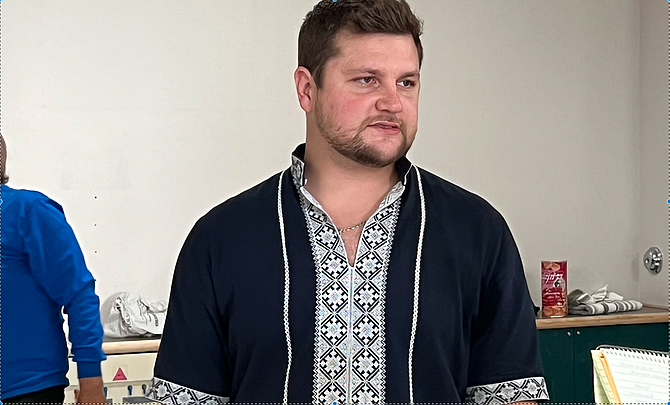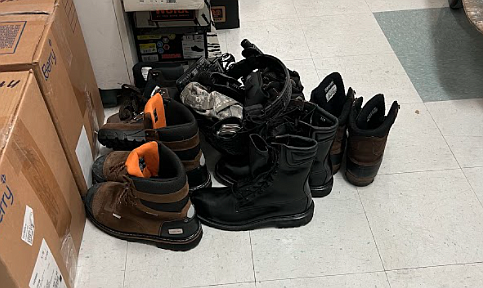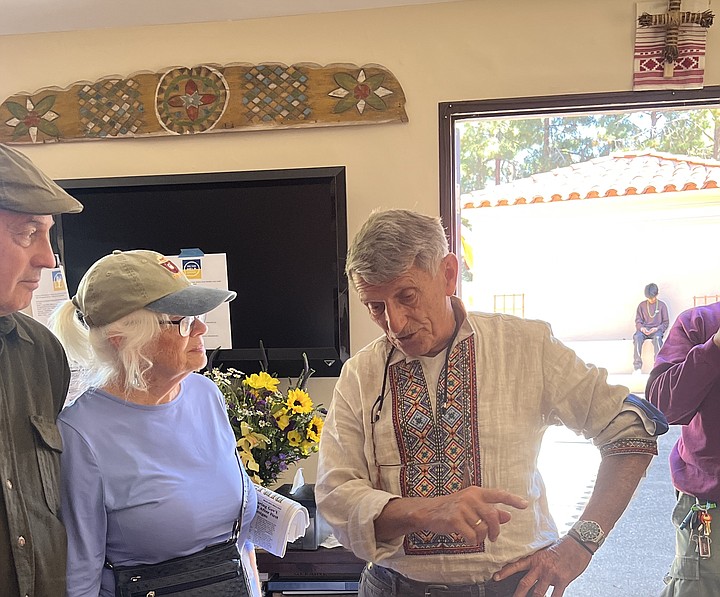 Facebook
Facebook
 X
X
 Instagram
Instagram
 TikTok
TikTok
 Youtube
Youtube

When my husband dropped off his old Marine Corps combat boots, flak jacket, and helmet at House of Ukraine in Balboa Park on Tuesday March 8, a volunteer thanked him profusely.
“We really need protective gear,” she told him, “we’ve only gotten five flak jackets so far.” Given a population of almost 250,000 veterans in San Diego, body armor should be rolling in. My husband’s Nextdoor post about his donations has gotten 801 likes. But only one response was from someone following suit: a Navy chief contributing boots, helmets, and Camelback water containers.

To beef up the supply of military gear, House of Ukraine is partnering with Ace Uniforms to offer a 10 percent discount on tactical apparel that the company will then ship to Ukraine.
By Saturday March 12, when we stopped by House of Ukraine again, the war was already more dire. Volunteer vice president Nadia Haywas was receiving a stream of well-wishers filing through the tiny space, dropping tens and twenties in a makeshift donation box in exchange for tokens of appreciation: tee shirts, totes, bumper stickers and mugs bearing the slogan “Stand with Ukraine.”

“We are grateful for all donations, the community has been very generous with their outpouring of concern. We need more, we need people contacting their Congress people and requesting they support a no-fly zone over Ukraine and NATO support,” Haywas added. “It is time for NATO to step in. This is already a world war, but only Ukrainian forces are fighting for the world.”
“Ukraine is the shield that protects Europe,” said Nadia’s husband, Askold, a former U.S. Marine. Their son is a Navy pilot.
“The wounded are now coming into hospitals in the West [of Ukraine],” Haywas explained to a group gathered around her. “We need medical supplies for the front line, and that’s what we’re doing with monetary donations.” Volunteers are now steering material donations to a warehouse at 4660 El Cajon Boulevard, in the City Heights landmark Asia Business Center.

“Military gear is most in demand,” said warehouse organizer Andriy Fedunyak, along with “medical supplies for serious wound care”: sterile gauze, bandages, tourniquets, dressings. They have more diapers than they can handle. Used clothing donations can no longer be accepted, but they’re prioritizing new, heavy clothes that will keep people warm in a country where many are living through winter without electricity.
“Someone brought in binoculars that we thought were his from the U.S. military,” Fedunyak shared, “but when we opened them up there was a note telling us they were his father’s — from World War II.” To him, these personal items show how much people care.
At the warehouse, where Ukrainian news is on 24/7, volunteers packed 500 boxes for the first load of supplies that went out last week. Via Eastern European shipping company Meest, donations were trucked to L.A., then flown to Chicago. From there they go by air to Poland, then by truck over the border. Fedunyak thinks the first load will arrive in Ukraine by the 19th. The second load is almost ready to go.
“Right now forces are organized around towns — territorial defense — so civilian militias will most likely distribute the supplies.” Andriy and his mother Olga have been working together in the warehouse. Andriy’s grandmother, aunts, uncles, and cousins are in Ukraine, in the western part of the country.
“People might be able to buy these kinds of things,” he said, “but as the war goes on demand goes up, supply goes down, and prices go way up. We’re supplying it for free to them so they can worry about other things.”


When my husband dropped off his old Marine Corps combat boots, flak jacket, and helmet at House of Ukraine in Balboa Park on Tuesday March 8, a volunteer thanked him profusely.
“We really need protective gear,” she told him, “we’ve only gotten five flak jackets so far.” Given a population of almost 250,000 veterans in San Diego, body armor should be rolling in. My husband’s Nextdoor post about his donations has gotten 801 likes. But only one response was from someone following suit: a Navy chief contributing boots, helmets, and Camelback water containers.

To beef up the supply of military gear, House of Ukraine is partnering with Ace Uniforms to offer a 10 percent discount on tactical apparel that the company will then ship to Ukraine.
By Saturday March 12, when we stopped by House of Ukraine again, the war was already more dire. Volunteer vice president Nadia Haywas was receiving a stream of well-wishers filing through the tiny space, dropping tens and twenties in a makeshift donation box in exchange for tokens of appreciation: tee shirts, totes, bumper stickers and mugs bearing the slogan “Stand with Ukraine.”

“We are grateful for all donations, the community has been very generous with their outpouring of concern. We need more, we need people contacting their Congress people and requesting they support a no-fly zone over Ukraine and NATO support,” Haywas added. “It is time for NATO to step in. This is already a world war, but only Ukrainian forces are fighting for the world.”
“Ukraine is the shield that protects Europe,” said Nadia’s husband, Askold, a former U.S. Marine. Their son is a Navy pilot.
“The wounded are now coming into hospitals in the West [of Ukraine],” Haywas explained to a group gathered around her. “We need medical supplies for the front line, and that’s what we’re doing with monetary donations.” Volunteers are now steering material donations to a warehouse at 4660 El Cajon Boulevard, in the City Heights landmark Asia Business Center.

“Military gear is most in demand,” said warehouse organizer Andriy Fedunyak, along with “medical supplies for serious wound care”: sterile gauze, bandages, tourniquets, dressings. They have more diapers than they can handle. Used clothing donations can no longer be accepted, but they’re prioritizing new, heavy clothes that will keep people warm in a country where many are living through winter without electricity.
“Someone brought in binoculars that we thought were his from the U.S. military,” Fedunyak shared, “but when we opened them up there was a note telling us they were his father’s — from World War II.” To him, these personal items show how much people care.
At the warehouse, where Ukrainian news is on 24/7, volunteers packed 500 boxes for the first load of supplies that went out last week. Via Eastern European shipping company Meest, donations were trucked to L.A., then flown to Chicago. From there they go by air to Poland, then by truck over the border. Fedunyak thinks the first load will arrive in Ukraine by the 19th. The second load is almost ready to go.
“Right now forces are organized around towns — territorial defense — so civilian militias will most likely distribute the supplies.” Andriy and his mother Olga have been working together in the warehouse. Andriy’s grandmother, aunts, uncles, and cousins are in Ukraine, in the western part of the country.
“People might be able to buy these kinds of things,” he said, “but as the war goes on demand goes up, supply goes down, and prices go way up. We’re supplying it for free to them so they can worry about other things.”
Comments